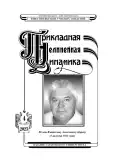About theory of hybride TWTO and an amplifire with a complex permittivity
- Authors: Funtov A.A.1
-
Affiliations:
- Saratov State University
- Issue: Vol 31, No 4 (2023)
- Pages: 452-468
- Section: Articles
- URL: https://journals.rcsi.science/0869-6632/article/view/250976
- DOI: https://doi.org/10.18500/0869-6632-003050
- EDN: https://elibrary.ru/UWBSKL
- ID: 250976
Cite item
Full Text
Abstract
About the authors
Aleksandr Andreevich Funtov
Saratov State University
ORCID iD: 0000-0002-9121-1449
Scopus Author ID: 55965777100
ul. Astrakhanskaya, 83, Saratov, 410012, Russia
References
- Duan Z., Shapiro M. A., Schamiloglu E., Behdad N., Gong Y., Booske J. H., Basu B. N., Temkin R. J. Metamaterial-inspired vacuum electron devices and accelerators // IEEE Transactions on Electron Devices. 2019. Vol. 66, no. 1. P. 207–218. doi: 10.1109/TED.2018.2878242.
- Rashidi A., Behdad N. Metamaterial-enhanced traveling wave tubes // In: IEEE International Vacuum Electronics Conference (IVEC). 22-24 April 2014, Monterey, CA, USA. New York: IEEE, 2014. P. 199–200. doi: 10.1109/IVEC.2014.6857559.
- Ulisse G., Krozer V. W-band traveling wave tube amplifier based on planar slow wave structure // IEEE Electron Device Letters. 2017. Vol. 38, no. 1. P. 126–129. doi: 10.1109/LED.2016.2627602.
- Birdsall С. К., Brewer G. R., Haeff A. V. The resistive-wall amplifier // Proceedings of the IRE. 1953. Vol. 41, no. 7. P. 865–875. doi: 10.1109/JRPROC.1953.274425.
- Birdsall С. К., Whinnerу J. R. Waves in an electron stream with general admittance walls // J. Appl. Phys. 1953. Vol. 24, no. 3. P. 314–323. doi: 10.1063/1.1721272.
- Лопухин В. М., Веденов А. А. Усилитель на поглощении // УФН. 1954. Т. 53, № 1. С. 69–86. doi: 10.3367/UFNr.0053.195405c.0069.
- Цейтлин М. Б., Кац А. М. Лампа с бегущей волной. М.: Советское радио, 1964. 308 с.
- Rowe T., Behdad N., Booske J. H. Metamaterial-enhanced resistive wall amplifier design using periodically spaced inductive meandered lines // IEEE Transactions on Plasma Science. 2016. Vol. 44, no. 10. P. 2476–2484. doi: 10.1109/TPS.2016.2599144.
- Jiang Y., Lei W., Hu P., Song R., Ma G., Chen H., Jin X. Demonstration of a 220-GHz continuous wave traveling wave tube // IEEE Transactions on Electron Devices. 2021. Vol. 68, no. 6. P. 3051–3055. doi: 10.1109/TED.2021.3075922.
- Касаткин Л. В. Об усилении волн пространственного заряда при прохождении пучков электронов в средах с индуктивной проводимостью // Радиотехника и электроника. 1961. Т. 6, № 2. С. 267–274.
- Овчаров В. Т., Солнцев В. А. Упрощенные нелинейные уравнения лампы бегущей волны // Радиотехника и электроника. 1962. Т. 7, № 11. С. 1931–1940.
- Datta S. K., Kumar L. Plasma frequency reduction factor // Defence Science Journal. 2008. Vol. 58, no. 6. P. 768–770. doi: 10.14429/dsj.58.1705.
- Branch G. M., Mihran T. G. Plasma frequency reduction factors in electron beams // IRE Transactions on Electron Devices. 1955. Vol. 2, no. 2. P. 3–11. doi: 10.1109/T-ED.1955.14065.
- Вайнштейн Л. А., Солнцев В. А. Лекции по сверхвысокочастотной электронике. М.: Советское радио, 1973. 399 с.
Supplementary files










